| Scientific
method of pig rearing under ARYA at Titaguri village under Kokrajhar
district (BTAD)
Introduction:
Livestock rearing plays and important role in the tribal economy of
Kokrajhar district as bulk and preferential diet for tribal people is
an animal origin protein i.e. pork,chicken, egg and fish etc. Almost
every tribal household of the district rear at least one or two pigs
in backyard but still a gap exist between demand and availability of
pork in the market. The main reason in the insufficiency for production
is rearing of mostly indigenous pig which has less productivity, lack
of knowledge about scientific pig farming, feeding and breeding management
of pig. The Titaguri is one of the village of Kokrajhar districts having
211 household with population of 1807 (2011 census) which is situated
just 5 KM away from BTC secretariat of Kokrajhar district.Mr. Rahul
Narzary, an enthusiastic youth of age 34 from Titaguri,Kokrajhar was
enrolled under the ARYA project and provided skill training on scientific
piggery farming. Initially he started his farm with 11 numbers of indigenous
pigs in tethering system. With continuous monitoring and supervision
from KVK, Kokrajhar he successfully established one piggery unit with
initial support of 10no’s of improved verities piglet, pig sty,
feed, vaccine and medicine. With this capital support from the project
and strong self-determination towards self-employment he has produced
more than 120 piglets per annum from breeding sow raised in his farm.
Now he is expanding his pig farm with total numbers of 60 sow and boar
in his breeding unit. Due to huge market opportunity for piglet &
pork in tribal people dominated Kokrajhar district, he sale piglet and
pork in farm gate and daily market of Kokrajhar town at Rs.4000/- per
piglet and Rs.300/- per kg pork. The consumers highly accepted his quality
piglets and pork in Kokrajhar town that contributed total income of
Rs 35000-40000/months by selling piglet and pork only. Further, with
existing piggery unit he started different poultry enterprise viz.,
Duckery, turkey and dual purpose poultry farming. He also started a
feed mill in his neighbor village. With established piggery and poultry
enterprise currently he is earning Rs 450000-500000 annually. Seeing
his success in pig farming many unemployed youth are motivated and came
forward for multiplication of similar livestock and poultry enterprise
nearby the area. Mr. Narzary also been awarded best piggery farmer in
“National livestock & Poultry Show” organized by Dept.
of AH & Veterinary, Assam for the year 2019 and awarded the best
piggery farmer in the Kokrajhar district for the year 2020-21 on republic
day by district administration.
Interventions
1. Before initiation of project, imparted knowledge and skill training
on scientific pig farming
2. Constructed concrete pigsty for each group of youth to rear pigs
3. Provided critical input i.e. Quality piglet,feed, medicine and supplements.
4. Periodical deworming and vaccination for FMD, swine fever and suggestion
for disease management and prevention
5. Market link up with different stakeholders
Output of the enterprise:
1. Quality piglet production as a profitable income generating venture.
2. Trained rural youth
3. Technology accepted and adopted
4. Additional income generated
5. Linkage with different line department
6. Self-employment
Perception of others in the village:
Positive attitude develops towards pig breeding and fattening as lucrative
enterprise in tribal dominated Kokrajhar district
Conclusion:
Scientific pig breeding as an enterprise which is profitable as compare
to their traditional method of rearing with less piglet mortality and
diseases occurrence, reduction cost with a high economic return. The
success of the youth has inspired and created interest among the local
youth for taking up piggery as an entrepreneurial venture.
|
Scientific
method of Eri rearing
Introduction:
Sericulture plays an important role in the rural economy of the North
Eastern Region (NER) of India and is called the Queen of Textiles. It
has always been the choice of fabric of Royalty and Nobility. Mulberry
and eri silk worm are reared indoor while tasar and muga are reared
outdoor. Among these commercially exploited silkworms viz mulberry,
muga and tassar; eri silkworms is completely domesticated multi-voltine,
poly-phagus species under non mulberry sector which is reared throughout
the year.
Eri silk culture is indigenous to the North-Eastern region of India
and Kokrajhar district was not an exceptional. It comes from the silkworm
Philosomiaricini that feeds mostly on the leaves of the castor plant,
Ricinus communis. The unique thing in Eri silk is the type of cocoon
as its fiber is not reeled.Further, the woolly cotton like behaviour
white silk is often referred to as the Ahinsa silk or the fabric of
peace as the process does not involve the killing of the silk worm.
Moths leave the cocoon as soon as it is ready to be spun. The cocoon
is open-ended and the moth emerges by its own or worm is extracted.
The matured worm is also an exotic food in most tribal people of the
district and referred as a food of delicacy among Bodo community of
the region.
Rearing of eri silk worm is almost a prerogative of tribal people of
the district and inherited from one generation to other as a tradition.
It was believed that ericulture is a poor’s man job and a leisure
time activity and is a secondary source of income for clothing and food.
The rearing of eri silk worm through traditional method was reported
in decreasing trend by many authors and thus it was also noted that
rural youth of the district are found migrated to other state in search
of income avenues as eri silk rearing for livelihood strategy is unsure.The
contributing factors of decreasing trend in eri silk rearing are due
to lack of awareness of scientific method of rearing, availability and
knowledge of secondary and tertiary food plants, lack of knowledge on
intercropping of agricultural crop with sericulture crops, post cocoon
technologies, poor management of infected larvae and mortality and morbidity
of eri pupae in different temperature, relative humidity and environmental
factors.Hence, scientific intervention of ericulture over traditional
method was found utmost important to save this old age tradition by
attracting rural youth towards ericulture.
Interventions
o Scientific method of eri rearing leads to more cocoon production than
traditional method of cocoon rearing.
o Availability of eri food plant leads to round the year cocoon production
and hence castor, kesseru and tapioca plantation is encouraged in farmer’s
field by providing seedlings and seeds.
o Space is well utilized in scientific method of eri rearing.
o In scientific method of eri rearing eri larvae are less susceptible
to disease, mortality and morbidity.
o Tensile strength of yarn is increased if primary or secondary food
plant as castor or kesseru respectively followed by tapioca is provided
as feed to larvae.
o Yarn making through use of Takli( hand Spinning machine) is time consuming
over motorized solar operated 3 in 1 spinning machine.
Output of the enterprise: Farm income
• Total income from sale of cocoon annually is Rs 12,750 X 5 times
in a year = Rs.63,750/
• Sale of eri pupae annually is Rs. 80 kg 5times = 400kg X @ 250/-
per Kg = Rs.1,00,000/-
• Sale of diversified hand woven products Annually is Rs. 4000/-
per shawl X 5 no.s= 20,000/-.
• The products are collected by local aggregators or sale in local
market without any brand name.
o Gross income : Rs. 1,87,000/-
o Net income : Rs. 1,63,000/-
Benefit to farmers:
The benefit to the farmers is as follows:
| Cocoon production |
15 KG |
| Pupae |
80 KG |
| Eri rearing done till date |
5 times |
| Eri egg produce for next rearing |
300 dfls |
| Cost of cocoon/kg |
Rs. 850/- |
| Cost of pupae/ kg |
Rs 250/- |
| Total crop rearing in a year |
5 times |
| Average Income from pupae/ crop |
RS 200/- x 80 Kg = 16000/- |
| Average income from cocoon/ crop |
Rs 850/- X 15 kg= 12750/- |
• Total income from sale of cocoon annually
is Rs 12,750 X 5 times in a year = Rs.63,750/-
• Sale of eri pupae annually is Rs. 80 kg 5times = 400kg X @ 250/-
per Kg = Rs.1,00,000/-
• Sale of diversified hand woven products Annually is Rs. 4000/-
per shawl X 5 no.s= 20,000/-.
• The products are collected by local aggregators or sale in local
market without any brand name.
o in terms of increase in income :Rs. 1,83,000/-
o in terms of reduction of cost : Rs.45,000/- (Purchasing of food plant
and eri egg is reduced)
o in terms of market linkages established :
o Eri cocoon are collected by local aggregators or sale directly to
Department of sericulture, Gossaigaon/Kokrajhar for yarn production.
o Pupae are sold in local market as it is the exotic food among Bodo
community.
Perception of others in the village:
o Eri culture is a profitable business.
o Rearers don’t have to run to sale there goods as goods are sale
at their door step.
o Eri cocoon are non perishable and hence can be stored in any jute
bag or bamboo tray.
o Eri larvae which is a proteinous food and are in high demand in local
market.
o Eri cocoon can be treated with chemical and thus yarn can be easily
spun in solar operated spinning machine where electricity is a main
constrain in remote village areas.
Conclusion:
Rearing of eri silk worm is a traditional method of rearing. Scientific
intervention in this field leads to more production without compromising
cocoon quality and quantity. Product diversification and value addition
of hand-woven fabric made out of eri yarn with traditional Bodo design
will attract more community and thus cater more market. |






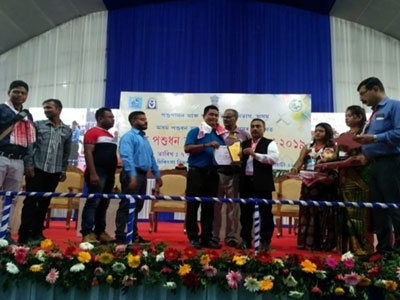

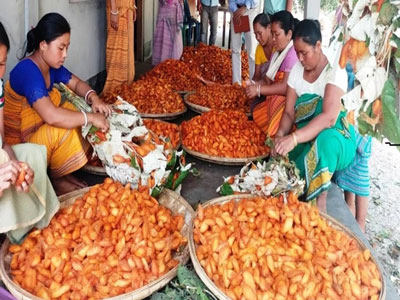
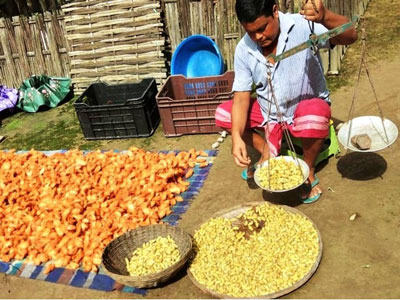
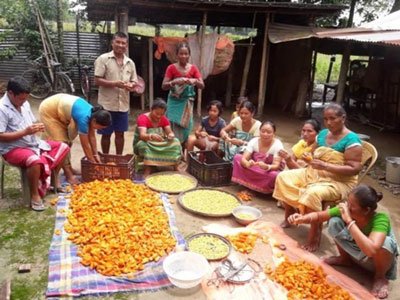
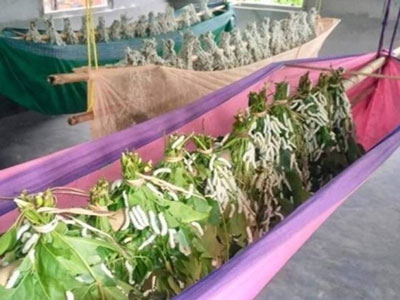
 |
|  |
|  |
| 
 Krishi Vigyan Kendra, AAU, Kokrajhar.
Krishi Vigyan Kendra, AAU, Kokrajhar.